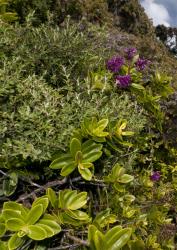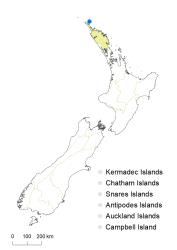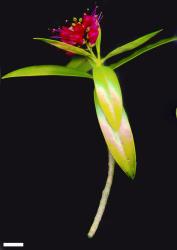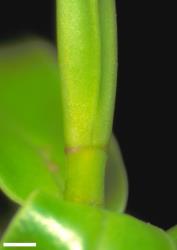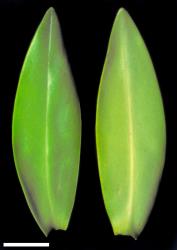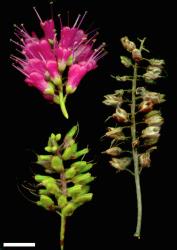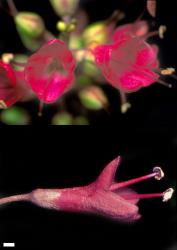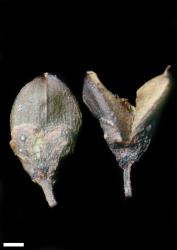- Taxon
- Gallery
- ≡ Veronica speciosa var. brevifolia Cheeseman, Man. New Zealand Fl. 500 (1906)
- ≡ Hebe macrocarpa var. brevifolia (Cheeseman) L.B.Moore in Allan, Fl. New Zealand 1, 908 (1961)
- ≡ Hebe brevifolia (Cheeseman) de Lange, New Zealand J. Bot. 35: 1 (1997)
Spreading, low shrub to 0.7 m tall. Stems decumbent to erect, eglandular-puberulent; hairs uniform. Leaf bud distinct, its leaves appressed at margins until fully grown; sinus absent. Leaves opposite-decussate, erecto-patent to spreading; lamina coriaceous, lanceolate to narrowly to broadly elliptic or obovate, 16–75 mm long, 6–25 mm wide, glossy green to dark green above, dull light green to green beneath; midrib evident; surfaces with eglandular hairs along midrib, or sometimes glabrous above, glabrous or sometimes minutely eglandular-hairy beneath; margins minutely ciliolate, becoming glabrous, entire; apex obtuse to sub-acute, sometimes very weakly plicate-acuminate; base cuneate; petiole absent. Inflorescence a lateral raceme, 20–96 mm long; flowers crowded, 16–57, all bisexual; bracts alternate or loosely whorled, or two lowest sub-opposite, obovate, elliptic, or deltoid, < pedicels; pedicels spreading, 1–7 mm long, eglandular-puberulent all around. Calyx lobes 4, obtuse to broadly rounded, or sometimes sub-acute, 1.5–2.0 mm long, sub-equal, mixed glandular- and eglandular-ciliolate. Corolla 6–8 mm diameter; tube magenta to deep rose-pink, 3.0–5.5 mm long, > calyx, glabrous or eglandular-hairy inside; lobes 4, magenta to deep rose-pink, sub-erect to spreading, sub-equal, elliptic to ovate, 3.0–3.5 mm long, obtuse to rounded; nectar guides absent. Stamen filaments magenta to purplish, 5.0–10.5 mm long; anthers red-purple. Style glabrous, 7.5–11.8 mm long. Capsules latiseptate, sub-acute to acuminate, glabrous, 4.5–7.5 mm long, 4–5 mm at widest point. Seeds discoid to ellipsoid, flattened, finely papillate, pale to dark brown, 1.7–2.4 mm long.
V. punicea is distinctive because only it and V. speciosa are characterised by dark magenta corollas. V. speciosa plants differ in their broader leaves that are rounded at the apex, leaf bud with a sinus, glabrous stems, longer inflorescences with usually more flowers, longer pedicel hairs, shorter corolla tubes (< twice the calyx), ciliolate corolla lobes, and often smaller seeds.
V. punicea was treated by Moore (in Allan 1961) as a part of the V. macrocarpa complex (as Hebe macrocarpa var. brevifolia). Plants of some forms of V. macrocarpa have similar broad and rounded calyx lobes, short inflorescences, and large capsules and seeds, but they differ in their white or purplish corollas and longer hairs on stems and inflorescences.
North Island: Northland (Surville Cliffs and nearby surrounding plateau).
Low shrubland on ultramafic rocks and soils. Recorded elevations range from 152 to 182 m.
Flowers: October–May (extending to August); fruits: January–May (persisting all year).
2n = 118 (see Bayly & Kellow 2006, as Hebe brevifolia).
Veronica punicea is classified in V. subg. Pseudoveronica sect. Hebe and the informal group “Occlusae” (Albach & Meudt 2010; Bayly & Kellow 2006).



